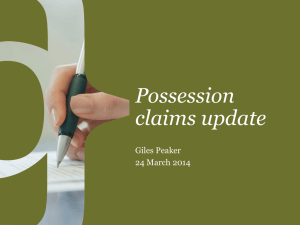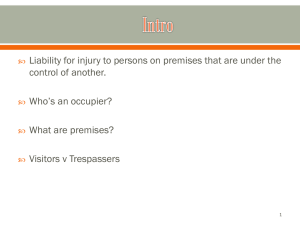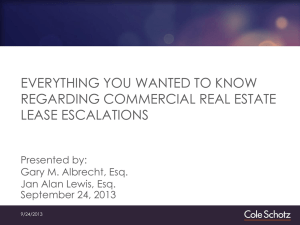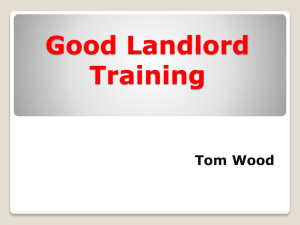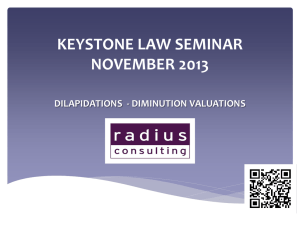implied warranty of habitability - Iowa Pest Management Association
advertisement
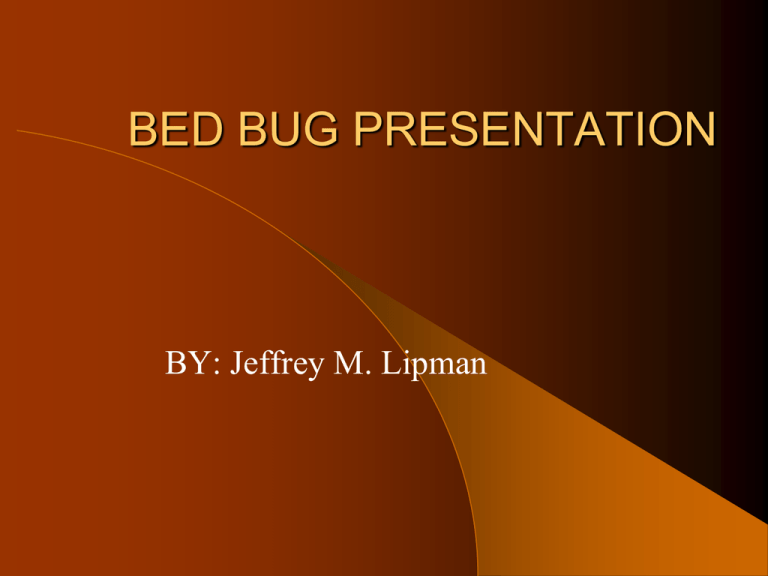
BED BUG PRESENTATION BY: Jeffrey M. Lipman DOCUMENT YOUR ADVICE Pest control operators are at risk of being named in a lawsuit. It is extremely important to document your action plan and alternatives in writing. FOLLOW THE ACTION PLAN Hotel/Motel and apartment managers will be named in most lawsuits. Extremely important to follow the action plan and document compliance: Written action plan approved by pest control provider; Written engagement contract specifying bedbug eradication & management; Have pest control company provide requirements for treatment readiness; Make sure tenants are prepared for treatments; Have written post treatment follow up plan. LANDLORD AND HOTEL'S DUTY TO TENANTS & GUESTS 1. 2. Provide a habitable premises Protect from clear & present danger CLEAR & PRESENT DANGER Conduct which presents an immediate and serious danger to the safety of other tenants or the landlord. LANDLORD OR HOTEL MUST ACT 1. Warn guests of danger (bedbugs) 2. Evict tenants who interfere with bedbug eradication. 3. Assist tenants who are mobility impaired with preparation for treatment. ONGOING DUTY TO INVESTIGATE 1. 2. Bedbug monitors. Periodic inspections as recommended by pest control operator. PREMISES LIABILITY Courts have adopted a seven (7) factor multifactor formula for analyzing premises liability actions (1) The foreseeability of possibility of harm; (2) The purpose for which the entrant entered the premises; (3) The time, manner, and circumstances under which the entrant entered the premises; (4) The use to which the premises are put and expected to be put; (5) The reasonableness of the inspection, repair, or warning; (6) The opportunity and ease or repair or correction or giving of the warning; (7) The burden on the land occupier and/or community in terms of inconvenience or cost in providing adequate protection. IMPLIED WARRANTY OF HABITABILITY An implied warranty of habitability is a warranty implied by law that by leasing a residential property, the lessor is promising that it is suitable to be lived in and will remain so for the duration of the lease. CASE LAW Courts have recognized the obligation of a landlord to provide his tenant with premises suitable for habitation. Under this doctrine, the landlord "impliedly warrants at the outset of the lease that there are no latent defects in facilities and utilities vital to the use of the premises for residential purposes." WHEN LIABILITY ARISES A landlord "is only liable for injuries resulting from a hidden or latent defect if the landlord knew or should have known of the defect." Implicit in this standard is the rule that a landlord must, on some occasions, make reasonable inspections to search for latent defects. LANDLORD'S OBLIGATION The landlord's obligation is only to do what is reasonable under the circumstances. The landlord need not take extraordinary measures or make unreasonable expenditures of time and money in trying to discover hazards unless circumstances so warrant. Where there is a potential serious danger which is foreseeable, a landlord should anticipate the danger and conduct a reasonable inspection before passing possession to the tenant. However, if no such inspection is warranted, the landlord has no such obligation. REASONABLE INSPECTION "Under this standard, the landlord has a duty to conduct a reasonable inspection before passing possession to a tenant when there is potential serious danger, which is foreseeable." In this context, the trigger of the duty to perform an inspection is the foresee ability of a latent defect that could lead to serious danger. UNFAIR DECEPTIVE ACTS & PRACTICES Rental units may not contain illegal hazards that endanger the occupant’s well-being or that make the unit unfit for habitation. A landlord who rents out an apartment impliedly represents that it is in compliance with the applicable health and safety codes. If it is not, the landlord has committed a UDAP violation. Collection of the full amount of rent while the unit is in violation of the housing code or where the unit had material defects rendering it unsafe or unfit is a UDAP violation. Spaulding v. Young, 32 Mass. App. Ct. 624, 592 N.E.2d 1348 (1992) Landlord is liable under UDAP statute if conditions seriously or materially impair the health or safety and well being of an occupant, whether or not the conditions violate the Sanitary or Housing Code. Pierce v. Reichard, 593 S.E. 2d 787 (N.C. Ct. App. 2004) Landlord is liable for UDAP violation and treble damages for failing, despite tenant’s complaints, to repair premises for leaky roof. Unfair to collect rent on an apartment containing numerous defects making it unfit and uninhabitable, where the landlord had notice of those defects and did not correct them. EXAMPLE Massachusetts’ highest court has affirmed a $61,475 treble damages judgment against a landlord who rented an uninhabitable apartment to a tenant, refused to repair it, and was abusive and threatening to the tenant. Haddad v. Gonzalez, 410 Mass. 855, 576 N.E.2d 658 (1991). EXAMPLE 2 Grundberg v. Gill, 56 Mass. App. Ct. 1116, 780 N.E.2d 158 (Mass. App. Ct. 2002) (unpublished) Affirming UDAP treble damages where landlord knew or should have known that failure to correct septic system would result in a severe emotional distress and breach of warranty. UDAP MEASURE OF DAMAGES A North Carolina court holds that the measure of damages for substandard housing conditions is the difference between the fair rental value of the property in the warranted condition and its actual fair rental value, but damages can not exceed the total amount of rent paid by the tenant. Cardwell v. Henry, 549 S.E.2d 587 (N.C. App. 2001 A landlord’s continuous and systematic breach of the implied warranty of habitability has been found to be unfair. Although not every breach of warranty would be a violation, either an egregious or a continuous one would be, as where the landlord continuously failed to remedy defects despite notices and judicial proceedings. Substantial and material breach of implied warranty of habitability is a UDAP violation, even if negligent. DUTY TO DISCLOSE The landlord must disclose all violations of law in the unit, and must correct or pay to correct all such violations. EXAMPLE Underwood v. Risman, 414 Mass. 96, 605 N.E.2d 832 (1993) Landlord is responsible only for disclosing hazards of which he has actual knowledge. Even if a landlord rents a unit not knowing about serious housing violations, it is unconscionable for the landlord to fail to remedy the violations. RATIONALE The tenant is in an untenable position of having to move out or live with substandard conditions. Clearly, the UDAP statute was designed to afford Plaintiffs the ability to pursue claims against landlords who withhold vital information about the health and safety of their leased units. UNJUST ENRICHMENT The doctrine of unjust enrichment is based on the principle that a party should not be unjustly enriched at the expense of another or receive property of benefits without paying just compensation. Although it is referred to as a quasi-contract theory, the doctrine of unjust enrichment is equitable, not contractual, in nature. The doctrine of unjust enrichment serves as a ground for the remedy of restitution. ELEMENTS One asserting a claim of unjust enrichment must establish three propositions: (1) defendant was enriched by receipt of a benefit, (2) the enrichment was at the expense of the plaintiff, and (3) it is unjust to allow the defendant to retain the benefit under the circumstances. PUNITIVE DAMAGES CASE The leading bedbug case discussing punitive damages is Mathias v. Accor, 347 F.3d 672 (7th Cir. 2003) In Mathias, Judge Posner, writing for the Seventh Circuit, reviewed a diversity case brought in federal court against Motel 6 in downtown Chicago where residents of the hotel were bitten by bedbugs. A jury awarded the 2 Plaintiffs each $5,000 in compensatory damages and $186,000 in punitive damages. HOTEL’S ARGUMENT The hotel argued that it was, at best, negligent and that an award exceeding $20,000 would be excessive. JUDGE POSNER’S THOUGHTS Judge Posner ruled that "evidence of gross negligence, indeed of recklessness in the strong sense of an unjustifiable failure to avoid a known risk was amply shown." Id at 674. FACTORS RELIED UPON (1) Discovery of the bedbugs; (2) Failed attempts at spraying the rooms to exterminate the bedbugs; (3) Warnings by an exterminator that the building needed to be closed while every room was sprayed and refusal of the hotel to comply; and (4) Knowledge of a management-level employee of the defendant of the risk and failure to take effective steps to wither eliminate it or to warn guests ("which are imputed to his employer for the purpose of determining whether the employer should be liable for punitive damages") In Mathias, Judge Posner pointed out that the infestation continued and began to reach farcical proportions. After pointing out, “odd that at that point [Management] didn't flee the motel”. Judge Posner discussed that the hotel acknowledged to the exterminator that there was a "major problem with bed bugs" and that all that was being done about it was "chasing them from room to room." The court understood that “although bedbugs bites are not as serious as bites from other insects, they are painful and unsightly. Motel 6 could not have rented any rooms at the prices it charged had it informed guests that the risk of being bitten by bedbugs was appreciated. Its failure either to warn guests or to take effective measures to eliminate the bedbugs amounted to fraud and probably battery as well. . . ” RELIANCE NOT REQUIRED (Most of the time) Generally, courts are more receptive to consumer fraud class actions than common law fraud class actions in view of relaxed reliance and causation requirements. Reliance on the prohibited practice or act is not required. In fact, recovery is permissible even if the plaintiff should have discovered the fraud or otherwise should have known of it. FRAUD NEED NOT BE CONVEYED TO PLAINTIFF Further, the misrepresentation need not be made directly to the plaintiff. Raudebaugh v. Action Pest Control, Inc., 650 P.2d 1006, 1009 (Or. 1982) (termite inspector falsely claimed to the homeowner that the house was free of insect infestation, later buyer relied on that statement could sue the termite inspector under statute.); Warren v. MeMay, 491 N.E.2d 464, 474 (Ill. App. Ct. 1986). RELIANCE IN OTHER STATES States that do have reliance elements emphasize that reliance may be wholly unreasonable and refer to the effect on the "unsophisticated consumer" when determining whether or not an act or practice is deceptive. Murphy v. McNamara, 416 A.2d 170 (Comm. Super. 1979) (statute must be applied to protect the unsuspecting and the credulous as well as the sophisticated.) MAJORITY APPROACH DAMAGES The majority approach under most state consumer law statutes is "benefit of the bargain", value of product/services as represented less value as delivered, which is more favorable to the consumer than "out of pocket" approach. COMPENSATORY DAMAGES INCLUDE All compensatory damages presumably include consequential and incidental damages, including repair costs and lost profits, where foreseeable and otherwise recoverable under damages rules. see e.g., Hyder-Ingram Chevrolet, Inc.v. Kutach, 612 S.W.2d 687 (Tex. App. 1981) LIABILITY STEMS FROM UNCERTAINTY HAVE A CONTRACT HAVE A FEE STRUCTURE INSURANCE CONTRACT HAVE TERMS IN WRITING SPECIFY WORK TO BE PERFORMED NO GUARANTEED – OR WILL BE LIMITED SPECIFY CLIENT’S DUTIES TO PREPARE FOR TREATMENT SPECIFY COSTS OF TREATMENT AND AFTERCARE WHAT IF CLIENT DOES NOT WANT TO SPEND THE $$$$ PCO WILL REFUSE THE JOB PCO WILL HAVE CLIENT SIGN DOCUMENT WITH THEIR RECOMMENDATIONS AND DECLINIATION PCO WILL SEND POST CONTRACT CONFIRMATION LETTER FEE STRUCTURE IN WRITING REQUIRE PCO TO PROVIDE WRITTEN ESTIMATE PCO SHOULD SPECIFY WORK TO BE PERFORMED PCO SHOULD SPECIFY INITIAL COSTS PCO SHOULD MAKE SURE FUTURE COSTS ARE NOTED AGAIN, NO GUARANTEES PCO INSURANCE GENERAL LIABILITY POLICY (probably will not cover much) GLP GENERALLY DOES NOT COVER BEDBUGS (need a rider) MAKE SURE AGENT INFORMED IN WRITING OF YOUR NEEDS AND POSSIBLE EXPOSURE INSURANCE FOR BUILDING LIKELY WILL COVER BODILY INJURY (Premises Liability) LIKELY WILL COVER PROPERTY DAMAGES (Premises Liability) UNLIKELY WILL RECOVER REBATE IN RENT UNLIKELY RECOVER ATTORNEY FEES UDAP UNFAIR DECEPITIVE ACTS & PRACTICES CONSUMER FRAUD: Actual + Triple damages + Attorney fees GENERALLY NOT COVERED BY INSURANCE SOMEONE HAS TO PAY GENERALLY DEEP POCKET THAT MEANS YOU GETTING SUED CALL YOUR INSURANCE CARRIER CALL A LAWYER DO NOT CALL THE PLAINTIFF OR HIS LAWYER DO NOT TALK TO THE PRESS (nothing good comes from this) THE QUESTION IS NOT “WHETHER” – RATHER “WHEN” (It is a numbers game) IOWA CLASS ACTION MODEL PROPERTY DAMAGES REBATE IN RENT PERSONAL INJURY ATTORNEY FEES UDAP PROPERTY DAMAGES BEDDING FURNITURE CLOTHING EXAMPLE LOW SIDE: $250 REBATE IN RENT VALUE OF INFESTED UNIT = $0.00 MONTHLY RENT: NUMBER OF MONTHS $ 500 X 3 ______ $1,500 PERSONAL INJURY DISFIGUREMENT FROM BITES: PAIN & SUFFERING (DISTRESS): MEDICAL BILLS: $2,000 $2,000 $ 500 ______ $4,500 UDAP TREBLE DAMAGES (TRIPLE) OR ACTUAL + TREBLE (4X) PROPERTY DAMAGES $ 250 X 3 = $ 750 REBATE IN RENT (3 MONTHS) $1,500 X 3 = $4,500 PERSONAL INJURY (NON UDAP) $2,500 X 1 = $2,500 _____ $7,750 ATTORNEY FEES LOADSTAR: PREVAILING RATE X HOURS = $$$$$ 1 DAY WORK UP + 1 DAY TRIAL = 16 HRS RATE: $300 HR 16 X $300 = $4,800 TOTAL COST SINGLE RESIDENT $12,550 CLASS ACTION PER PLAINTIFF PLAINTIFFS $ 7,750 x 100 _______ $775,000 ATTORNEY FEES $350,000 TOTAL LOW SIDE: $1,125,000 THIS ASSUMES PRE-TRIAL SETTLEMENT LIABILIY STEMS FROM NO WARNINGS NO ACTION ARROGANCE

